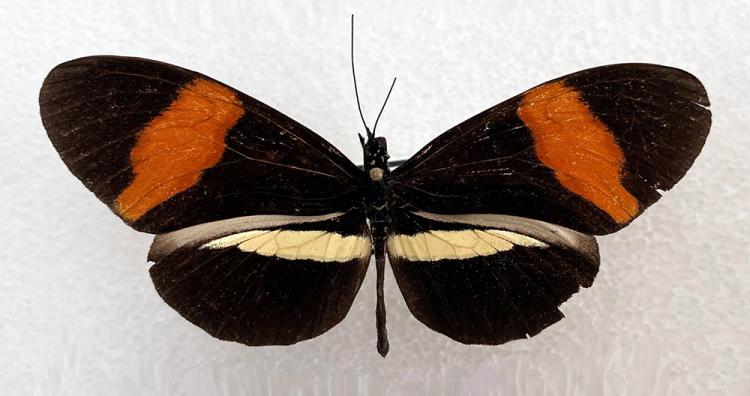The CU Museum is closed we will be opening early in the spring semester.
During this time, collection visits will be available by appointment and other special access requests will be considered on a case-by-case basis.
Please email cumuseum@colorado.edu for more information.
Heliconius Butterfly

Heliconius adults live a relatively long adult life for a butterfly—up to 8 months. This requires them to be especially good at avoiding predators. One way that Heliconius have evolved to avoid being eaten is to mimic the wing patterns of related species that are toxic to predators.
Heliconius butterflies alone have 43 species with hundreds of subspecies, just one of the factors that make them a great research organism. Living butterflies are being studied now, but to learn how they have evolved from butterflies of the past, we turn to natural history collections.
The basic question of how organisms change through time and space in response to the environment, helps us understand our world. Finding answers is increasingly relevant to predicting how organisms might respond to environmental changes caused by human-induced change. Natural history museum collections’ specimens provide a window to the past, and a record that spans time and geography, within and between species. Each species studied by scientists becomes a page in the story we read of life on earth.
A reminder that scientists don’t spend all their time with butterfly nets and DNA sequencing machines: species name use a standardized binomial nomenclature so they are universally consistent. Scientists who discover a new species have the freedom to name it. In the case of these butterflies, Helicon is a mountain in Greece that was regarded as the source of poetry and inspiration. The species names of many of the Heliconius butterflies come from those of the mythological muses that inhabited Helicon. Today’s WoW, H melpomene, is named for the muse of tragedy and rosina is a variant of “rose”. And, in case you didn’t notice, the very word ‘museum’ also derives from those muses. WoW!
Lopez, L., Turner, K. G., Bellis, E. S., & Lasky, J. R. (2020). Genomics of natural history collections for understanding evolution in the wild. Molecular Ecology Resources, 20(5), 1153–1160. https://doi.org/10.1111/1755-0998.13245
Gilbert, L. E. (1972). Pollen feeding and reproductive biology of Heliconius butterflies. Proceedings of the National Academy of Sciences of the United States of America, 69(6), 1403–1407. https://doi.org/10.1073/pnas.69.6.1403
Beltrán, M., Brower. A.V.Z., Jiggins, C. (2013). Tree of Life Heliconius Kluk 1780 TS = Papilio charithonia L., 1767 (designated by Hemming, 1933). Longwings or passion-flower butterflies. http://www.tolweb.org/tree?group=Heliconius&contgroup=Heliconiini
heliconious.org. (2014). Butterfly Evolution from Jungles to Genomes. The Royal Society Summer Science Exhibition. http://www.heliconius.org/wp-content/uploads/2014/06/butterfly_evolution_leaflet_clean-1.pdf

